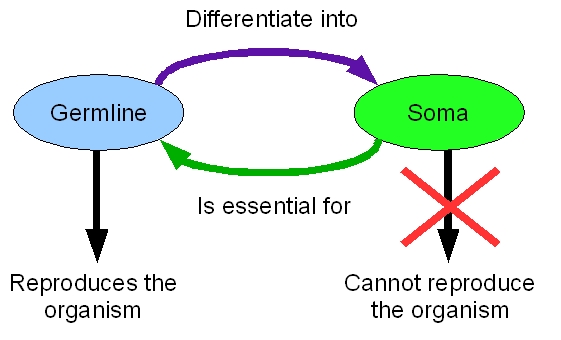Paris/Introduction
From 2007.igem.org
Contents |
Introduction
Why a Synthetic Multicellular Bacterium ?
Dealing with complexity
A major challenge for synthetic biology will be to tackle complexity. If you want to modify an organism so that it can perform complex tasks, you may wish to implement a complex circuit within a single cell. But, in order to do this, you would require very well characterized biobricks to be sure that your system will behave as predicted. And even if this is the case you may stumble upon unexpected interactions. A smarter approach might be to implement small simple parts of your circuit within different types of cells that would work together. The aim of our project is to provide a tool for such an approach, making a jump in complexity scale, from single cells to multicellular synthetic biology, and for the first time engineering a multicellular bacterium.
Avoiding unwanted interactions
For the moment only very few parts in the registry are well characterized. This leads to the fact that almost all the devices are made out of the same biobricks (plac, pBad, ptet, plambda, luxI, luxR…), and are thus incompatible (you cannot implement them in the same cell). Implementing them in different cell types could solve this problem…
A new tool for synthetic biology and metabolic engineering
In most multicellular organism there is a separation between the cell line devoted to reproduction, the germ line, and the one devoted to support the germ line and increase its likeliness of reproduction, the soma. The particularity of somatic cells, is that in a sense they sacrifice themselves for the benefit of the organism. In the same way, implementing a soma/germ line separation in a bacteria, could allow using the soma to produce compounds noxious for itself. In this perspective, our multicellular organism could become a great tool for metabolic engineering.
What is a multicellular organism and what do we need to create one ?
Grouping of cells
Organisms are living complex adaptive system composed of cells. Some organisms, such as bacteria or protozoa, are unicellular. Other organisms, such as humans, are multicellular.
E. coli is a bacterium able to form colonies but is a unicellular organism since a single cell is able to survive on its own if separated from the colony. On the contrary, the simplest living multicellular organisms, sponges, consist of four specialized cellular types unable to survive alone if separated. Colonial organisms, such as Volvox, are considered being an evolutionary intermediate between the unicellularity and multicellularity (click here to know more about the colonial theory of evolution of multicellularity). They are commonly classified as unicellular because individual cells are free-living and can survive on their own if separated from the colony.
It can be discussed whether the grouping of identical cells constitute a multicellular organism. Since there is no consensus on the subject, our design of a synthetic multicellular organism will include two cells types and we will define a multicellular organism as the necessary and sufficient existence of at least 2 cell types.
Cellular differentation
A basic property of multicellular organisms is the occurrence of cellular differentiation leading to complementary specialized functions and interdependency between different cell types. Cellular differentiation is the process by which a cell acquires a new cell type. A cell type is a distinct functional and/or morphological form of a cell. A cell able to differentiate into many cell types is known as pluripotent. Generally, differentiation leads to progressive restriction of the developmental potential and increased specialization of function (NCBI MeSH).
Differentiation needs signalling between and within cells leading ultimately to changes in gene expression patterns: some genes are turned on and other are turned off. Considering how gene expression may change, we can distinguish 2 forms of differentiations. Most of the time, it is epigenetic differentiation where mechanisms do not involve changes to DNA sequence: "classical" cis and trans gene regulation involving transcription factors, enhancers, repressors but also DNA methylations, DNA replication timing... The second form of differentiation involves changes to DNA sequence by recombination processes, for example during lymphocyte differentiation (V-D-J recombination).
Germ cells and somatic cells
In multicellular organisms, we can observe two categories of cells. Germ cells are responsible for the reproduction of the organism and the others, the somatic cells, are unable to build a new organism but are essential for the germ line. Most multicellular organisms reproduce through sex, and the germ line is responsible for the gametes production. We will not attempt to reproduce sexual behaviors, but only to make a separation between a line dedicated to reproduction, and one dedicated to support the other. They will be named the germ line and the soma, also we realize we are overextending the proper definition of those terms.
What will our synthetic multicellular organism look like?
We have defined a multicellular organism as the necessary and sufficient existence of at least 2 cell types. We wish to construct a multicellular organism based on E.coli. Our organism, will be composed of 2 cell types.
A first cell type is the germ cell (G cell). It is unable to live alone but able to give an entire organism (both cell types). It needs the second cell type to survive: the somatic cell. The somatic cell (S cell) comes from the G cell by differentiation and has a new function necessary for G cell survival. It is unable to give an entire organism.
Thus, our system is composed of an undifferentiated G cell type and a differentiated S cell type. Obligatory interdependency between these two cell types must ensure the stability of the system. The nature of this interdependency will be discussed below.


